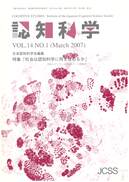Volume 14, Issue 1
Displaying 1-14 of 14 articles from this issue
- |<
- <
- 1
- >
- >|
Foreword
-
2007Volume 14Issue 1 Pages 1-2
Published: 2007
Released on J-STAGE: December 15, 2008
Download PDF (815K)
Messages to Members
-
2007Volume 14Issue 1 Pages 3
Published: 2007
Released on J-STAGE: December 15, 2008
Download PDF (904K) -
2007Volume 14Issue 1 Pages 4-5
Published: 2007
Released on J-STAGE: December 15, 2008
Download PDF (814K)
Feature: What Society Expects of Cognitive Science
-
2007Volume 14Issue 1 Pages 6-10
Published: 2007
Released on J-STAGE: December 15, 2008
Download PDF (901K) -
2007Volume 14Issue 1 Pages 11-30
Published: 2007
Released on J-STAGE: December 15, 2008
Download PDF (2278K) -
2007Volume 14Issue 1 Pages 31-38
Published: 2007
Released on J-STAGE: December 15, 2008
Download PDF (943K) -
2007Volume 14Issue 1 Pages 39-59
Published: 2007
Released on J-STAGE: December 15, 2008
Download PDF (1226K) -
2007Volume 14Issue 1 Pages 60-73
Published: 2007
Released on J-STAGE: December 15, 2008
Download PDF (964K) -
2007Volume 14Issue 1 Pages 74-89
Published: 2007
Released on J-STAGE: December 15, 2008
Download PDF (1689K)
Research Papers
-
2007Volume 14Issue 1 Pages 91-117
Published: 2007
Released on J-STAGE: December 15, 2008
Download PDF (1090K) -
2007Volume 14Issue 1 Pages 118-132
Published: 2007
Released on J-STAGE: December 15, 2008
Download PDF (1452K) -
2007Volume 14Issue 1 Pages 133-154
Published: 2007
Released on J-STAGE: December 15, 2008
Download PDF (1178K)
Literature Guide
-
2007Volume 14Issue 1 Pages 155-160
Published: 2007
Released on J-STAGE: December 15, 2008
Download PDF (715K)
Conference Report
-
2007Volume 14Issue 1 Pages 162-167
Published: 2007
Released on J-STAGE: December 15, 2008
Download PDF (695K)
- |<
- <
- 1
- >
- >|
